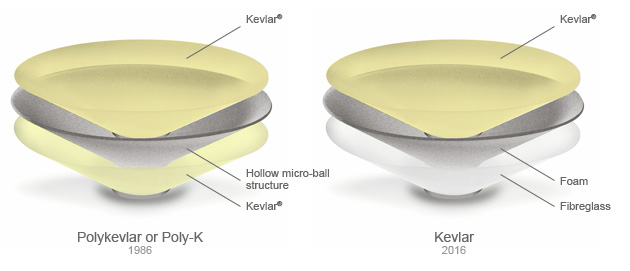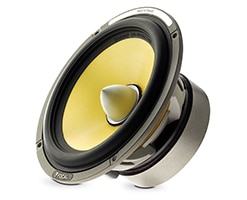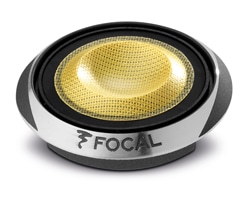M-SHAPED INVERTED DOME TWEETER
A major innovation of the K2 Power line, the inverted dome tweeter in aramid fibres benefit from a new profile: M-shaping.
The fourth generation of K2 Power kits, with their emblematic aramid fibre cone, remain true to the precious and distinctive K2 DNA. The speaker drivers combine performance, power and style, whilst including patented innovations to deliver the very best. Designed, developed and manufactured in our workshops in France, the 2-way coaxial kit EC 165 KE takes in-car listening to another level.
K2 Cone in aramid fibre
The K2 sound “signature”, high performance, dynamic and precise
TMD® surround
(Tuned Mass Damper) profile Patented technology, low distortion for perfect cone control
‘M’-profile inverted dome aramid fibre tweeter
Better dispersion of the sound, precise and sweet
Progressive profile spider
Increases the linearity, precision and dynamics of the sound
Engraved serial number
Certificate of authenticity
Aluminium frame
Rigid, non-magnetic and exclusive profile for better excursion
Integrated 6dB crossover
Simple installation
Integrated terminal block
More compact
ARAMID FIBRES SANDWICH CONE

Our Aramid fibres sandwich cone, recognisable by its distinctive yellow colour, is the symbol of K2 Power Car Audio line.


A HERITAGE CONE
Used in JMLab Vega or Antea high-fidelity speakers, the K2 sandwich cone was introduced for the first time in 1986 with the use of Polykevlar. The Poly-K cone is composed of two layers of aramid fibres, applied to either side of a hollow micro-ball structure in order to improve the balance between weight, rigidity and damping.
THE CONE AT THE HEART OF THE PERFORMANCE
In 2016, our Aramid fibres cone has evolved, but preserves its identity and the combination of its three key factors: rigidity, lightness and damping. The goal: guaranteeing high-quality audio reproduction whatever the genre of music you listen to.
It is now composed of a very light foam layer, between a layer of Aramid fibres and a layer of fibreglass, ensuring clear and precise sound void of any colouration.
M-SHAPED INVERTED DOME TWEETER
A major innovation of the K2 Power line, the inverted dome tweeter in aramid fibres benefit from a new profile: M-shaping.

Simulation at 15KHz

Finite element analysis

Finite element analysis
A FREQUENCY RESPONSE IMPROVED
This exclusive M-profile of the tweeter enables the extension of the frequency response to 22KHz, reducing distortion for a smoother diffusion and great precision in the very high end. Moreover, UV glue used on the voice coil reinforces its reliability and stability.

Frequency response comparison
M-profile inverted dome Tweeter / Inverted dome Tweeter

"M" tweeter is also associated with a push pull motor, inspired by IAL technology (sealed chamber) which improves bandwidth, reduces resonances and makes the treble more precise and smoother.
TMD - Tuned mass damper
The obsession with the midrange
The midrange register is no doubt the most complicated to control in a sound system. On one hand, there must be a smooth transition with the bass. On the other hand, it must be tuned to the tweeter in terms of dispersion and acceleration. This determines the homogeneity of the timbre and spatialisation.
For the past 20 years, we have been working on mastering the "break up" (the frequency at which the cone becomes deformed, leading to distortion) of our 3rd generation "W" cones and on drastically reducing the resonance of the tweeter with the IAL 2. Today, thanks to the power of finite element analysis, our teams have developed simulation software to visualise the dynamic behaviour of the suspension which connects the cone to the basket, thus revealing the performance issues requiring attention.
Tuned mass damper
Following the discovering of these issues, we had to conceive the equipment to solve them. The solutions already known for increasing the damping properties of the suspension all result in an increase of the mass which consequently alters definition. The answer came from a technology used in earthquake-resistant skyscrapers and which is also used for the suspension on racing cars! This technology is called a "Tuned Mass Damper": an additional mass oscillate in opposition to the resonance frequency to control it.
Applied to the speaker driver, the solution consists in simply two tubular rings on the suspension whose dimensions and position have been judiciously determined. They form our Tuned Mass Damper (TMD) and they stabilise the dynamic behaviour of the surround according to resonance, thus avoiding deformation of the cone without afflicting the dynamics. This innovation is patented.

Visual analogy of the surrounds


Our Tuned Mass Damper (TMD) consists of two tubular rings moulded onto the surround. On the left the default suspension, on the right, the TMD suspension. This simple solution, perfected thanks to our new software, stabilises the dynamic behaviour of the surround according to resonance, thus avoiding deformation of the cone without afflicting the dynamics.
Principle of the Tuned Mass Damper

The principle of the tuned harmonic damper (TMD): The graph on the left demonstrates the principle of the tuned mass damper. In red, an m1/k1 system with very pronounced resonance. By adding a mass/spring system m2/k2 (upper section of the diagram), there will be two resonance peaks, as represented by the blue curve. The drop or anti-resonance being previously based on the resonance of the main system, we get the green curve. Finally, by judiciously adding a damper, we obtain the purple curve. The resonance has almost disappeared!
With Sopra hi-fi speakers, we opted for exponentially shaped cones in order to increase frequency response, and consequently impulse response. Another reason for increasing definition.
Measurement and analysis

Improved response linearity between 1 and 2kHz and the frequency extension provided by the exponential cone profile..
Frequency response of our latest midrange driver (blue trace) compared to the previous-generation W-cone midrange, representing prior state-of-the art performance (red trace). Improvements to the magnetic circuit also contribute (see next section). NB: The dip at 3kHz in the blue trace is due to the tested driver not being fitted with a dust cap.

Effect of the harmonic damper on linearizing the frequency response between 1.5 and 2kHz (blue trace with TMD, red trace without).

Effect of the harmonic damper on nonlinear distortion, which is halved between 1.5 and 2kHz (blue trace with TMD, red trace without).
| Type | 2-way component kit |
|---|---|
| Maximum power | 200W |
| Nominal power | 100W RMS |
| Sensitivity (2.83V/1m) | 91 dB |
| Frequency response | 60Hz – 22kHz |
| Impedance | 4Ω |
| Cone | K2 Sandwich |
| Woofer | 61/2" (165mm |
| Voice coil diameter | 11/4" (32mm) |
| Depth | 27/8" (74mm) |
| Magnet | Ferrite |
| Surround | TMD® |
| Tweeter | 'M'-profile |
| Crossover | 6-12/12dB (3kHz) |